Boarding Devices and Aircraft Seats: Increasing Support and Comfort
Peter W. Axelson1 MSME, ATP, RET;
Jessica Presperin Pedersen2 MBA, OTR/L, ATP/SMS OTDs;and Seanna L. Hurley1 MS
1Beneficial Designs, Inc., Minden, NV
2Rehabilitation Institute of Chicago, Center for Rehabilitation Outcomes Measurement
Abstract
As more non-ambulatory people who use complex rehab wheelchair seating and mobility products are travelling, there is a need to create design concepts and establish parameters for assistive technologies for airline passengers. This Paralyzed Veterans of America (PVA) funded research project focuses on four aspects of airline travel for people who are non-ambulatory: 1) Use of boarding devices to get down the aisle of a plane to the aircraft seat, 2) Transfer issues related to transferring into and out of the aircraft seating from the boarding device, 3) Sitting on a standard economy airline seat for the duration of greater than a two-hour flight, and 4) Transporting and protecting the wheelchair when it is stowed in the belly of the aircraft. Outcome measures to examine aircraft boarding chairs, seating, transfer methods, and aircraft wheelchair storage practices are being collected. These include boarding chair and aircraft seating transfer times, sitting pressures, and body segment angles and postural measurements, which are compared to their personal wheelchair and baseline measurements of the participant. This paper addresses the boarding devices and the aircraft seating parts of the project, summarizing progress made during the first year of a two-year project. Initial findings are reported for 23 subjects that have participated thus far, out of a total of 32 planned subjects. Subject evaluations were completed in aircraft seats and three boarding devices, the Columbia Aislemaster, Staxi, and Eagle Lift. In addition, survey results for non-ambulatory wheelchair user’s actual travel preferences and experiences are reported. Initial concepts for assistive technology including portable add-on devices to assist with postural control, pressure distribution, and sitting tolerance for boarding chairs and aircraft seating are being developed. The need to develop design and performance standards for boarding devices has also been identified.
background
Travel by persons with mobility impairments is on the increase. As a result, the number of complaints submitted to the Department of Transportation has continued to increase. These complaints are mostly related to damage of assistive technologies, failure to provide assistance, and failure to provide seating accommodations (United States Department of Transportation, 2015). The United States Air Carrier Access Act prohibits discrimination to travelers with disabilities. Ramps or lifts must be provided for commuter type aircraft if a jet-way is not available for boarding (United States Department of Transportation, 1986). The airlines typically contract service providers that provide assistance to passengers with disabilities that need assistance to the gate and with boarding and deplaning the aircraft.
Since the aisles of most aircraft are typically about 18 inches wide in their economy sections, boarding chairs are the most common Boarding Devices (BD) used to board persons who are non-ambulatory onto commercial aircraft. The passenger that is non-ambulatory typically pre-boards the aircraft first before other passengers. Typically, two Travel Service Personnel (TSP) assist the wheelchair passenger to the end of the jet-way where the passenger transfers into the BD. Once the transfer is complete, the wheelchair is prepared for storage beneath the aircraft. If the passenger pre-boards the aircraft, one folding wheelchair is allowed for storage inside the aircraft. The TSP then rolls the BD from the jet-way onto the aircraft and backwards down the aisle of the aircraft to the seat that the passenger is sitting in. The flight attendants can assist the passenger with storing personal items in the overhead container or under the seat in front of where the passenger is sitting. The flight attendant will typically unlatch and lift the arm support to make it easier to transfer into the aircraft seat. In the economy section of the aircraft, most arm supports unlatch and lift up on the aisle seat to make it easier to transfer into the seat. If a passenger is sitting in business or first class seating, the arm support does not typically lift up and a transfer must be made over the arm support. The TSP then assists the passenger with the transfer into the aircraft seat if assistance is required. Aircraft without first class or business class seating, which also have open seating, can allow non-ambulatory passengers to sit in the front row. Front row aircraft seats allow for most manual wheelchairs to be rolled onto the aircraft directly to the seat for transfer into the seat.
Purpose
The purpose of this study was to investigate the following research questions:
- What are the needs and specifications for improving aircraft boarding chairs with reference to postural positioning and seating?
- What are the needs and specifications for improving postural stability and sitting tolerance in commercial aircraft seating?
Method
Evaluation of boarding devices
There are several different types of Boarding Devices (BDs) used to assist individuals who are non-ambulatory to transport from the jet-way to the aircraft seat. Three BDs were evaluated in this study at the Rehabilitation Institute of Chicago (RIC) in a simulated boarding process with adults of varying ages and diagnoses. The three BDs were the Aislemaster Columbia, Staxi, and the Hayman Eagle Lift.
Evaluation of aircraft seats
Aircrafts seats were also evaluated with subjects at the RIC. A simulated aircraft with a row of three side-by-side seats was used at RIC, as well as actual trips to the airport where airline terminals and aircrafts provided authentic opportunities for gathering evidence. Measurements of the size of the aircraft seats were made. Clinical notes on how the transfer into the aircraft seat was performed and how the individual sat in the seat were documented. Seating components and accessories providing pressure relief, comfort, and support were used to determine if they made a difference in postural support and comfort. This paper will summarize the postural support issues that have been noted with the subjects that have been tested to date.
Subjects
A total of 32 subjects will participate in the study and partial data has been collected on 23 subjects to date. The inclusion criteria for this project require that the subjects are non-ambulatory and non-weight bearing, use a wheelchair for full-time mobility, can tolerate multiple transfers, and are between the ages 18 to 70. Presence of a pressure sore is an exclusion criterion.
All subjects signed informed consent to the study protocol, including photo release. The study protocol was approved by the RIC Institutional Review Board (IRB).
Measurements
Measurements of the subjects and their wheelchairs were taken and compared to the three boarding devices and what was needed to assure postural support.
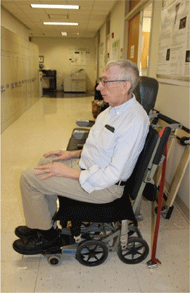
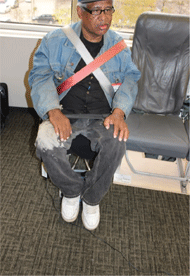
The BDs are also being tested at the Beneficial Designs wheelchair test laboratory for dimensions, strength and static stability.
Qualitative feedback
Individuals provided qualitative input as to perceptions of how it felt to be moved up ramps, over thresholds, and around sharp turns to simulate the boarding process. Comfort and posture in the BD were also noted along with pressure mapping of the seating interface compared to the seating in their personal wheelchair. The transfer methods to and from the boarding chair and the wheelchair and the aircraft seat were also documented.
In addition, a survey was developed: “Air Travel Survey for Assistive Technology for Non‐Ambulatory Passengers.” This survey was designed to collect feedback from wheelchair users who have had at least one experience with air travel in last 5 years. This survey was posted on Survey Monkey and has been distributed through many list serves and publications, such as the PVA monthly publication:
www.surveymonkey.com/r/wheelchairuserairtravelsurvey
results
Preliminary results testing boarding devices
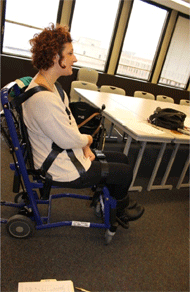
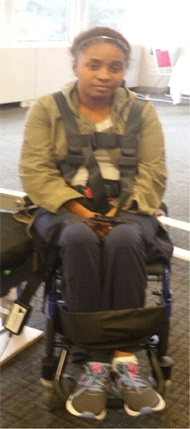
The Columbia and Staxi pivot to turn in completely different ways. The Columbia is a six-wheeled BD intended to pivot on the larger pair of wheels in the middle (Figure 1). The slight tipping movement front to rear can be discomforting to the user as the BD chair tips from the two front wheels to the two rear wheels when balanced on the middle wheels for pivoting. The Staxi BD is a four-wheeled device that pivots at the rear wheels more like a traditional wheelchair (Figure 2). Participants subjectively reported the Staxi BD has a smoother ride over thresholds and carpeting.
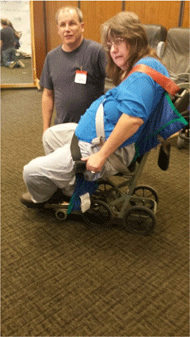
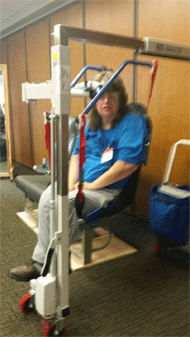
Online survey regarding boarding devices
As of January 15, 2016, 577 people had responded to the survey posted on Survey Monkey. Fifty-five percent of the respondents use a manual wheelchair, 7% use a manual wheelchair with power assist or add-on power, 33% use a power wheelchair, and 7% use other. Ninety-five percent of the respondents use a cushion in their wheelchair. Seventy-five percent of the respondents had used a Columbia BD, 33% had used a Genemax BD, 23% had used a Staxi BD, only 4% had used an Eagle BD, and 8% had used an older style BD that tips back on two wheels. Fifty-one percent of the respondents stated that they did not feel the BD fit their body and 55% stated that they felt unstable when they were on the BD.
Out of 273 individuals using a BD, 61% stating the seat was too narrow, 46% stated that the foot support was inadequate and that their feet fell off of the foot support, and 45% stated that they bumped up going over the threshold which correlates with the clinical observations. Most concerning were responses indicating that over 7% had fallen off of a BD and 12% had tipped over sideways in a BD.
Preliminary results regarding aircraft seating observations
The pressure mapping results indicate that for persons that need to sit on a pressure relief cushion, the pressures are higher sitting on the aircraft seat cushion by itself. If the users are sitting on their personal pressure relief cushion, the pressures are lower. For wheelchair users sitting on their pressure relief cushions on the aircraft seat, the additional height puts them higher than desired on the aircraft seat which often leaves the passengers feet off the floor of the aircraft. To promote circulation and comfort, a foot support is needed. A back pack can be used for a foot support or an inflatable foot support can provide the needed support to support the lower legs so that blood flow is not restricted to the lower legs.
On-line survey questions regarding aircraft seating
Out of the 577 survey respondents, 42% use their wheelchair cushion when sitting on the aircraft seat. The greatest complaint for individuals sitting on the aircraft seat was increased pain, 46%, followed by skin issues, 25.7%. It should be noted that 38% of the respondents use air filled cushions which are problematic to sit on during a flight since the change in altitude over-inflates the cushion. When the user lets the air out to adjust the cushion at the higher altitude, the cushion will be under-inflated when the aircraft descends and lands. It will bottom out with the user sitting on it. The cushion will need to be pumped back up upon landing.
Discussion
When a non-ambulatory traveler is sitting on their pressure relief cushion in an aircraft seat, the seating most often does not fit them well. For example, the lower legs often hang in the air on the front of the pressure relief seat cushion. This can result in a loss of circulation and swelling in the lower legs. To accommodate this situation, the non-ambulatory traveler would ideally have a foot support. An inflatable foot support was provided for subjects to use when sitting on their pressure relief cushion in the aircraft seat. Something like a back pack could also be used to provide foot support. Since the back support no longer fits very well, a lower lumbar support may be desired by some passengers. A neck support and lateral supports may be needed by other non-ambulatory travelers. Simple add on lateral supports were provided and offered to non-ambulatory subjects in the study. Non-ambulatory subjects communicated that it would be difficult to carry extra seating accessories for the purpose of sitting in aircraft seating. Testing is underway to determine the best type of lateral support for postural stability that will function properly with the aircraft seating.
Conclusion
At the midpoint of the data collection, 23 individuals have evaluated the boarding chairs and aircraft seats. Clinical observations note an increase in buttock pressure when using the Columbia and Staxi boarding chairs. Since the Staxi boarding chair does not have arm supports, it is more difficult to transfer for travelers without trunk stability. Statistical analysis will be completed when all 32 individuals have completed testing.
The online survey will be available until September of 2016. Please distribute the following link to complete the survey:
www.surveymonkey.com/r/wheelchairuserairtravelsurvey
The outcomes of this project will provide design specifications and information about seating accessories to improve the comfort and quality of the boarding device and aircraft seating for passengers who are non-ambulatory. To date, the investigators have determined that standards related to the stability, strength, and functionality of boarding devices need to be developed through an open and interdisciplinary standards development process. In addition, it has been determined that since pressure relief cushions often have to be used on top of existing aircraft seating that a variety of aircraft seating accessories could assist passengers with disabilities to sit in a more comfortable posture. Transfer issues and techniques for getting to and from the aircraft seating from the BD and storage concepts to prevent damage to wheelchairs are also being addressed as part of this grant.
References
United States Department of Transportation (DOT). (1986). Air Carrier Access Act of 1986. Retrieved February 16, 2015, from http://airconsumer.dot.gov/rules/382short.pdf.
United States Department of Transportation (DOT). (2015). Passengers with Disabilities. In Office of Aviation Enforcement and Proceedings. Retrieved February 16, 2015, from https://www.transportation.gov/airconsumer/passengers-disabilities
Waugh K, Crane B, Taylor S, Davis K, Cwertnia S. (2012). A Clinical Application Guide to Standardized Wheelchair Seating Measures of the Body and Seating Support Surfaces. Colorado, United States of America: University of Colorado, Assistive Technology Partners, through a grant from the Paralyzed Veterans Association. Retrieved February 16, 2015, from http://www.pva.org/atf/cf/%7BCA2A0FFB-6859-4BC1‑BC96‑6B57F57F0391%7D/Lib_Waugh%20Guide%20to%20Seating%20v2%20Measures%20Revised%20Ed.compressed.pdf
Acknowledgements
This research project is funded by the Paralyzed Veterans of America (PVA) Research Foundation Grant award #3028 - Airline Travel: Assistive Technology for Non-ambulatory Passengers.